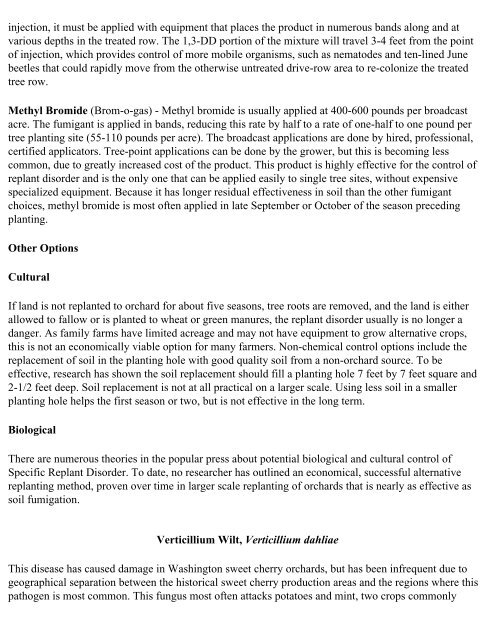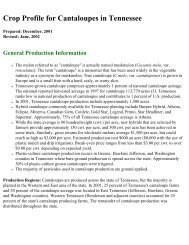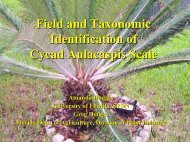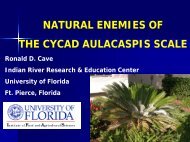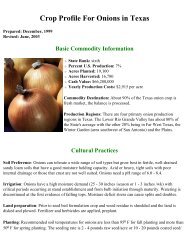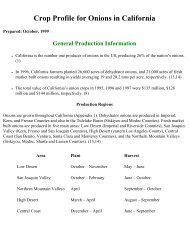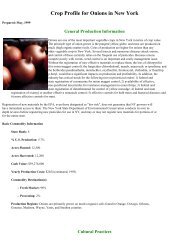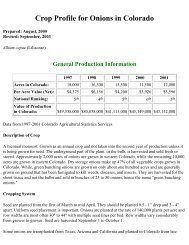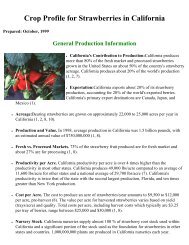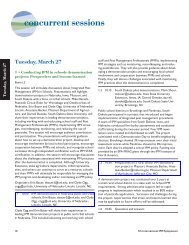Crop Profile for Cherries (Sweet) - Regional IPM Centers
Crop Profile for Cherries (Sweet) - Regional IPM Centers
Crop Profile for Cherries (Sweet) - Regional IPM Centers
You also want an ePaper? Increase the reach of your titles
YUMPU automatically turns print PDFs into web optimized ePapers that Google loves.
injection, it must be applied with equipment that places the product in numerous bands along and at<br />
various depths in the treated row. The 1,3-DD portion of the mixture will travel 3-4 feet from the point<br />
of injection, which provides control of more mobile organisms, such as nematodes and ten-lined June<br />
beetles that could rapidly move from the otherwise untreated drive-row area to re-colonize the treated<br />
tree row.<br />
Methyl Bromide (Brom-o-gas) - Methyl bromide is usually applied at 400-600 pounds per broadcast<br />
acre. The fumigant is applied in bands, reducing this rate by half to a rate of one-half to one pound per<br />
tree planting site (55-110 pounds per acre). The broadcast applications are done by hired, professional,<br />
certified applicators. Tree-point applications can be done by the grower, but this is becoming less<br />
common, due to greatly increased cost of the product. This product is highly effective <strong>for</strong> the control of<br />
replant disorder and is the only one that can be applied easily to single tree sites, without expensive<br />
specialized equipment. Because it has longer residual effectiveness in soil than the other fumigant<br />
choices, methyl bromide is most often applied in late September or October of the season preceding<br />
planting.<br />
Other Options<br />
Cultural<br />
If land is not replanted to orchard <strong>for</strong> about five seasons, tree roots are removed, and the land is either<br />
allowed to fallow or is planted to wheat or green manures, the replant disorder usually is no longer a<br />
danger. As family farms have limited acreage and may not have equipment to grow alternative crops,<br />
this is not an economically viable option <strong>for</strong> many farmers. Non-chemical control options include the<br />
replacement of soil in the planting hole with good quality soil from a non-orchard source. To be<br />
effective, research has shown the soil replacement should fill a planting hole 7 feet by 7 feet square and<br />
2-1/2 feet deep. Soil replacement is not at all practical on a larger scale. Using less soil in a smaller<br />
planting hole helps the first season or two, but is not effective in the long term.<br />
Biological<br />
There are numerous theories in the popular press about potential biological and cultural control of<br />
Specific Replant Disorder. To date, no researcher has outlined an economical, successful alternative<br />
replanting method, proven over time in larger scale replanting of orchards that is nearly as effective as<br />
soil fumigation.<br />
Verticillium Wilt, Verticillium dahliae<br />
This disease has caused damage in Washington sweet cherry orchards, but has been infrequent due to<br />
geographical separation between the historical sweet cherry production areas and the regions where this<br />
pathogen is most common. This fungus most often attacks potatoes and mint, two crops commonly


